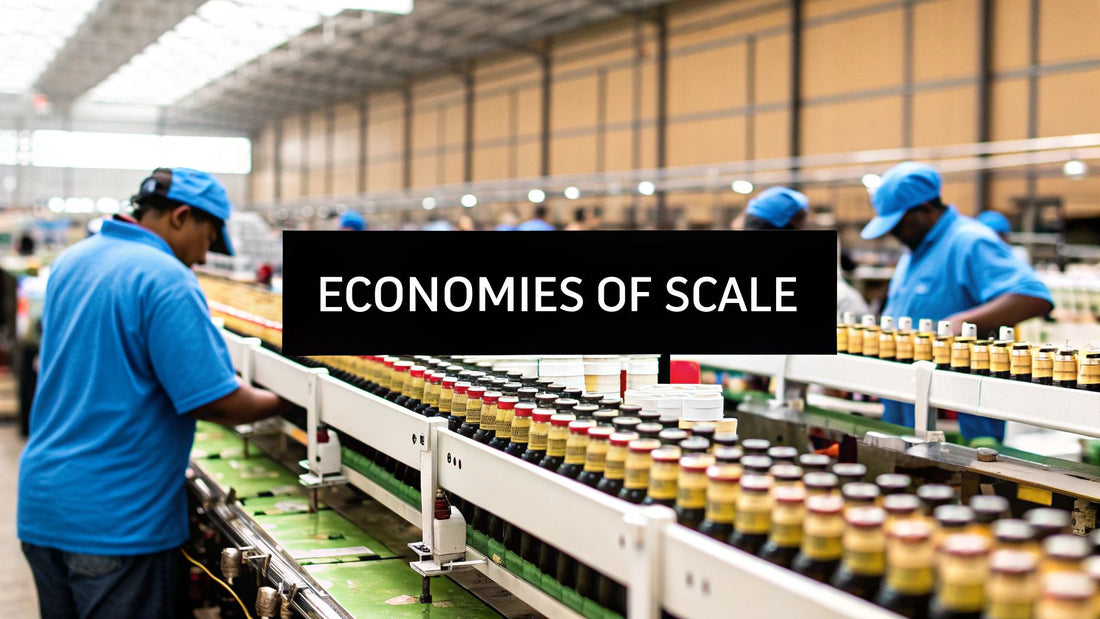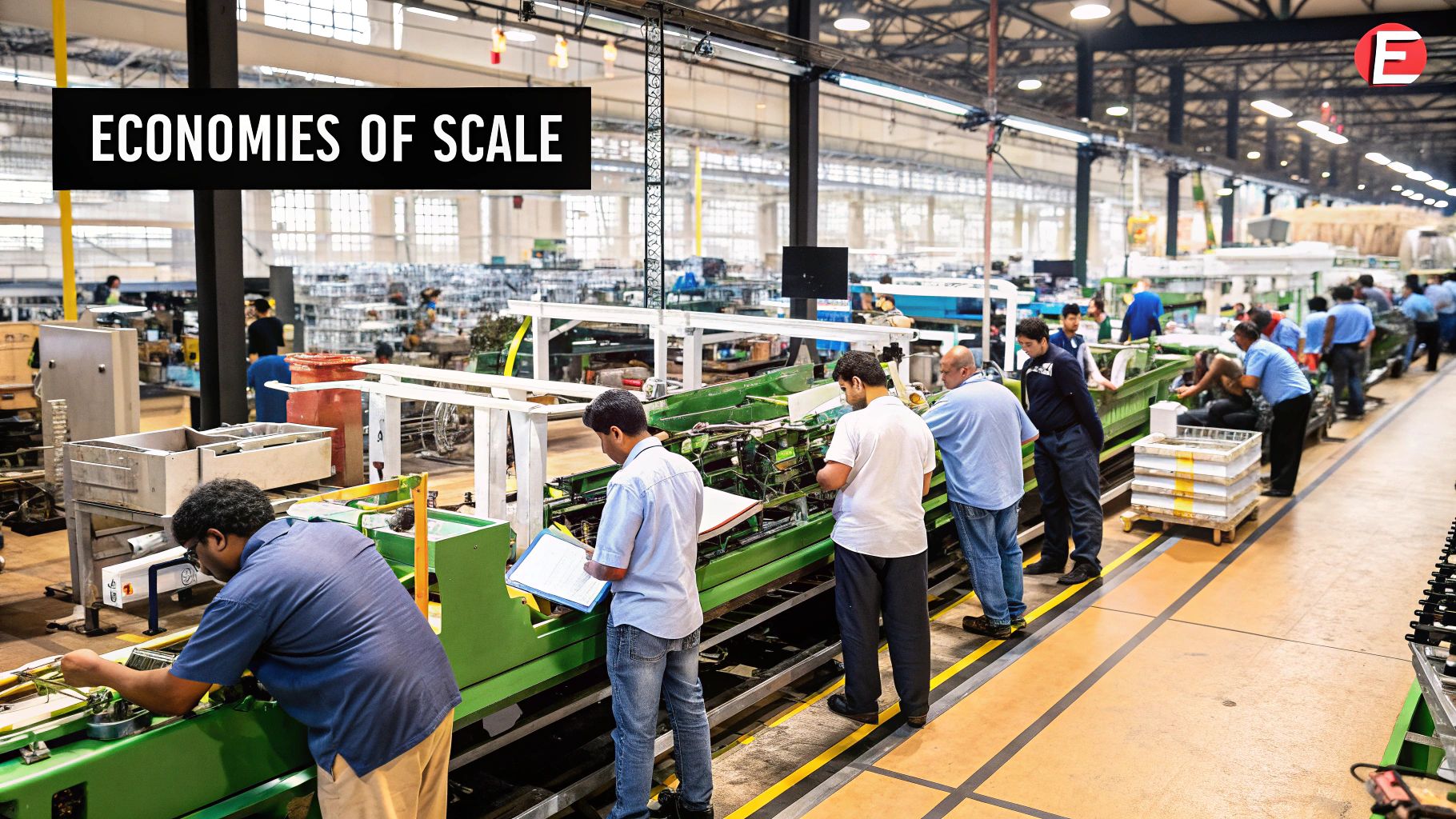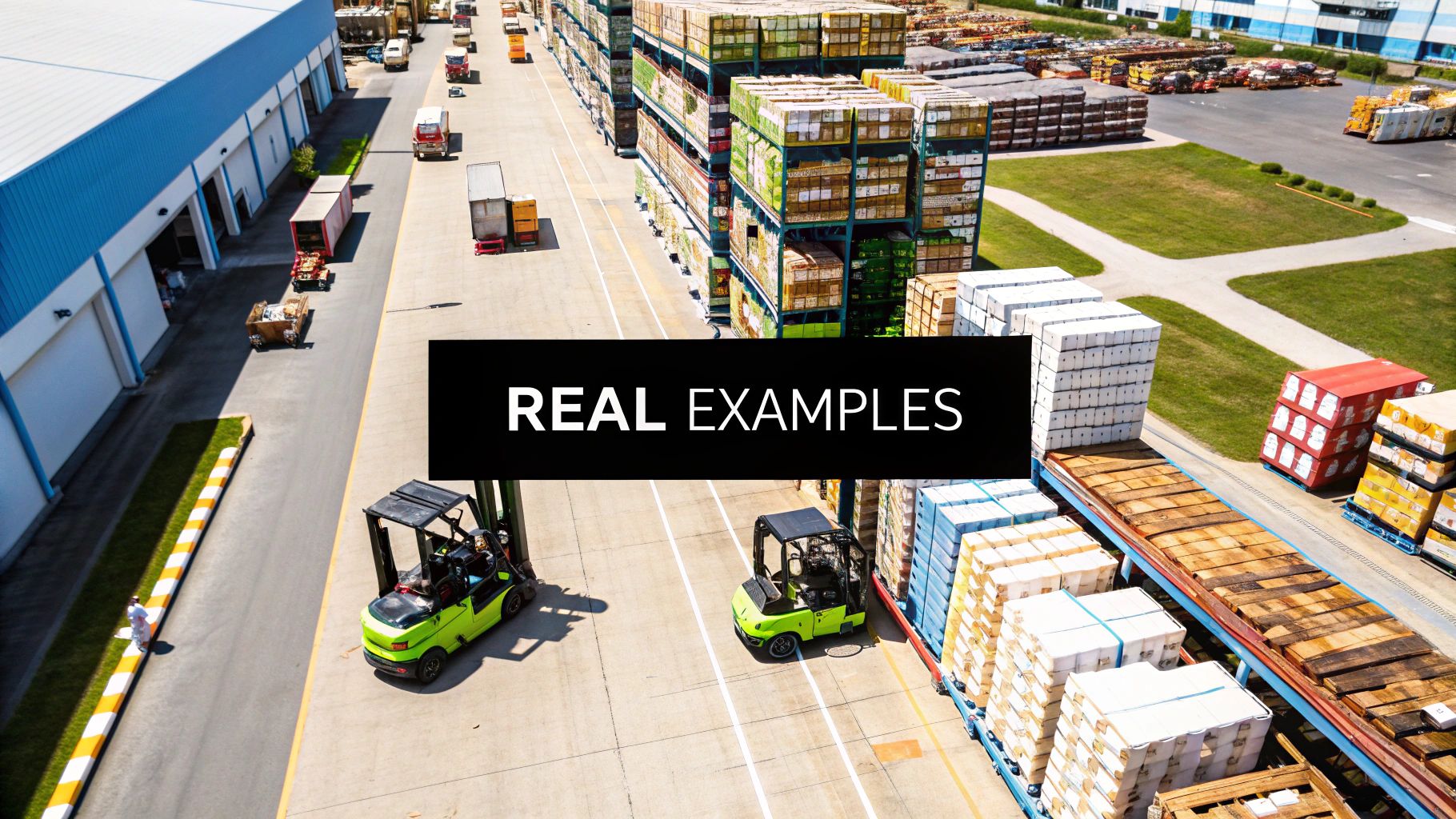
What Is Economies of Scale Explained
Share
Ever heard the phrase "bigger is better"? When it comes to business efficiency, there's a lot of truth to that. The core idea behind this is a concept called economies of scale.
Simply put, economies of scale is the cost advantage a business gets as it grows. The more you produce, the cheaper it becomes to make each individual item.
What Are Economies of Scale in Simple Terms?

Let's ditch the textbook definition for a moment and think about baking a cake. If you bake just one cake, you have to account for the cost of ingredients, your time, and the entire electricity bill for running your oven for that single cake.
Now, what if you opened a bakery and started making 100 cakes a day? The ingredient cost per cake stays about the same, but the cost of running that big commercial oven is now spread across all 100 of those cakes. Suddenly, the oven's cost per cake is tiny. That is economies of scale in a nutshell.
The Power of Spreading Costs
This isn't just about ovens; it's about all your fixed costs—the expenses that stay the same no matter how much you produce. Spreading these costs over a larger output is where the magic happens.
Think about common fixed costs:
- Rent: Your factory's rent is the same whether you make one gadget or one million.
- Machinery: That big, expensive piece of equipment you bought becomes a better deal with every single unit it churns out.
- Salaries: An office manager's salary covers the entire operation, not just a single product.
By cranking up production, a company essentially waters down these fixed costs over more and more units. This lowers the per-unit cost, which is a massive competitive advantage.
To make these ideas even clearer, here’s a quick breakdown of the core concepts.
Key Concepts in Economies of Scale
| Concept | Simple Explanation |
|---|---|
| Fixed Costs | Expenses that don't change with production levels (e.g., rent, salaries). |
| Variable Costs | Expenses that change directly with production (e.g., raw materials). |
| Per-Unit Cost | The total cost to produce a single item (fixed + variable costs / total units). |
| Increased Output | Producing a larger quantity of a good or service. |
As you can see, the goal is to increase output so those hefty fixed costs have less impact on the final price of each item.
At its heart, economies of scale is about working smarter, not just harder. It's the mechanism that allows growth to translate directly into greater efficiency and profitability.
This principle is why mass production works and how huge companies can offer prices that smaller competitors just can't match. It’s a fundamental force shaping everything from local shops to global supply chains, and understanding it is key to seeing how businesses win.
Internal vs. External Economies of Scale
When we talk about getting bigger to get cheaper, it’s not a one-size-fits-all situation. The cost advantages that come with growth actually show up in two very different ways. Getting a handle on the difference is key to really understanding how a business can achieve these efficiencies. The two main flavors are internal and external, and they stem from completely different places.
This infographic lays out the two main branches of the concept pretty clearly.

As you can see, it's all about whether the advantages are happening inside a single company or if they're benefiting an entire industry.
Internal Economies: The Company-Specific Edge
Internal economies of scale are the cost savings a business creates for itself as it grows. These are the advantages a company generates from within, entirely through its own decisions and actions. Think of them as self-contained efficiencies that are firmly under the company's control.
For instance, a huge automaker like Ford can demand massive discounts on steel because they buy it in such enormous quantities—a power a small, custom car shop simply doesn't have. In the same way, a tech giant like Amazon can afford to hire hyper-specialized engineers to squeeze every last drop of efficiency out of its server farms. This level of specialization is just not feasible for a smaller company.
These internal perks are a direct result of a company’s own operational size. You can see how different cost allocation methods become crucial for pinpointing and maximizing these internal efficiencies.
The big idea with internal economies is simple: the larger your own operation, the more muscle you have to drive down your costs through bulk purchasing, smarter technology, and specialized labor.
External Economies: A Rising Tide Lifts All Boats
On the flip side, external economies of scale are cost advantages that an entire industry benefits from, often just by being in the same place. These aren't benefits created by any single company, but rather by the local ecosystem that grows around them.
The classic example is Silicon Valley. Because so many tech companies are clustered there, it attracts a deep pool of skilled software engineers, specialized venture capital firms, and expert legal teams. This makes it cheaper and easier for every tech company in the area—from the garage startup to the global giant—to find the talent and resources it needs to succeed.
These external benefits truly do lift all boats, creating a powerful, self-reinforcing cycle of growth for the whole industry in that region.
Seeing Economies of Scale in Action
Theory is one thing, but seeing a concept play out in the real world is where it really clicks. To understand what economies of scale actually looks like, let's unpack two classic examples—one that defined an entire century and another that dominates our own. These aren't just business school case studies; they're perfect illustrations of how getting bigger can make you better and cheaper.
Our first stop is the early 1900s. Back then, cars were a luxury item, painstakingly assembled by hand for the wealthy. Henry Ford saw a different future, and his moving assembly line became the ultimate symbol of manufacturing scale.

Instead of having workers move around a stationary car, Ford had the car move to the workers. By breaking the assembly process into small, repeatable steps, he slashed the production time for a single Model T from over 12 hours down to just 1.5 hours. This incredible efficiency let Ford drop the car's price to as low as $260 in the 1920s, putting it within reach of the average American family for the first time.
Modern Giants and Digital Efficiency
Now, let's jump to a name everyone knows: Walmart. The company’s entire empire is a masterclass in economies of scale, built on two pillars: massive purchasing power and a hyper-efficient supply chain.
When Walmart orders products, they do it in such enormous quantities that suppliers have to offer them rock-bottom prices. This buying power gives them a cost advantage that smaller retailers simply can't match. They pass those savings on to us, the shoppers, which keeps us coming back and allows them to grow even bigger. It’s a powerful, self-perpetuating loop.
At its core, Walmart’s strategy isn’t just about being big; it’s about converting that size into tangible cost savings and competitive strength that others find nearly impossible to replicate.
This same idea is alive and well in the digital world. Think about the smart companies using SaaS automation strategies to cut down on manual work and operational costs. Just like Ford fine-tuned his assembly line, today's businesses are optimizing their digital processes to lower the cost of serving each customer, running each report, or delivering each service. It's the same principle, just with clicks instead of wrenches.
The Hidden Risks of Growing Too Big
Reaching economies of scale can feel like the ultimate business victory, but there's a catch. Unchecked growth can backfire spectacularly. Think of it like a balloon: a little air makes it bigger and better, but too much and it pops. A company can reach a point where getting bigger just makes things worse.
This is the tipping point where diseconomies of scale creep in. It’s that painful stage where your cost per unit actually starts to climb as you produce more. The very things that made you successful—your size and output—begin to work against you, creating a whole new set of problems.
What was once a lean, fast-moving startup can quickly become a tangled, bureaucratic giant, bogged down by its own weight.
When Size Becomes a Weakness
As a company expands, the gap between top leadership and the people doing the actual work on the front lines can turn into a massive chasm. This disconnect is often where the real trouble begins, undoing the very benefits you worked so hard to achieve.
You start to see common growing pains pop up:
- Slow Decision-Making: More layers of management mean simple approvals get stuck in a bureaucratic maze, causing you to lose out on timely opportunities.
- Communication Breakdowns: A simple message from the top can get distorted or lost completely as it trickles down the organizational chart, leading to confused teams and duplicated work.
- Declining Employee Morale: When people feel like just another number in a giant corporate machine, their motivation plummets. This leads to lower productivity and a revolving door of talent.
The agility and passion that drive a company's early success can easily be smothered by the sheer weight of its own structure, turning its size from an asset into a liability.
Finding the Right Balance
The smartest companies know that growth is a balancing act. They chase expansion but are always on the lookout for the warning signs of diseconomies of scale. It’s one thing to grow, but it's crucial to understand how to scale a business effectively without creating a system that collapses under its own complexity.
This means building systems and a company culture that can actually handle the extra weight of expansion. True, sustainable success isn't just about getting bigger—it's about getting bigger better. If you want to dig deeper into keeping these growing pains in check, exploring the principles of strategic cost management is a great next step for any scaling business.
How the Pursuit of Scale Forged Modern Industry

Economies of scale isn't just a term you hear in a business school lecture; it’s a powerful force that literally built the world we live in today. To really get a feel for its impact, let's take a quick trip back to 19th-century America—a period of massive, almost unbelievable, change.
Before this era, most things were made locally. Think small workshops, where skilled artisans crafted goods one piece at a time. But a new way of thinking was taking hold, one centered on a relentless drive for efficiency. The move from tiny workshops to sprawling, centralized factories was more than just a change in architecture; it was a fundamental reinvention of production itself.
By going all-in on mass production and specialization, industries could churn out goods at a cost and speed that were simply unthinkable just a generation earlier. This historical view makes it clear: the quest for efficiency was one of the key engines of the Industrial Revolution.
The Rise of the Factory
This period marked a documented and dramatic shift toward bigger manufacturing operations. In fact, research digging into post-1850 census data shows that between 1850 and 1880, the chance of a business being a factory—defined as having 16 or more employees—jumped by nearly 20%. This scaling up of production laid the groundwork for the global corporate world we know now. You can dive deeper into these historical manufacturing trends in the full analysis.
This transition didn't happen by accident. It was the deliberate, strategic application of scale, proving a simple but powerful idea: making more could make everything cheaper, more accessible, and, in the end, more profitable.
Understanding this history helps us connect the dots to today. Businesses are still chasing the benefits of scale, whether by building massive physical plants or by growing their user base on digital platforms. In fact, many are getting creative with models like group buying for business to pool their purchasing power, showing how the core concept of scale is always finding new forms.
Your Questions About Scale, Answered
As we've unpacked the power of getting bigger to get more efficient, a few common questions always pop up. It's easy to get tangled in business jargon, so let's clear the air on some of the finer points.
Think of this as your quick reference guide. We'll sort out the tricky concepts so you can see exactly how they play out in the real world.
What's the Difference Between Economies of Scale and Economies of Scope?
This is probably the most frequent mix-up, and for good reason—both are about cutting costs. The trick is to remember if you’re making more of the same thing or making different things using the same setup.
-
Economies of Scale: This is all about producing a higher volume of a single product to lower the cost of each one. Imagine a bakery that can make a single croissant for less money when it bakes 1,000 a day instead of just ten. The efficiency comes from specializing and repeating one task perfectly.
-
Economies of Scope: This happens when you lower the average cost across multiple products by sharing your resources. That same bakery could use its ovens, staff, and counter space to also sell muffins and cookies. Because the overhead costs are spread out, it's cheaper to produce each type of baked good.
The easiest way to think about it: Scale is about depth (doing more of one thing), while scope is about breadth (doing more related things).
Can Small Businesses Actually Benefit From Economies of Scale?
Yes, absolutely. You don't need a massive factory to find efficiencies. While a local business can't match a global corporation's purchasing power, small companies get creative to achieve scale on their own terms.
A neighborhood coffee shop, for instance, can get a better price per pound on beans by placing larger, less frequent orders. A freelance writer achieves scale by investing in a top-tier grammar tool that cuts down editing time, allowing them to take on more projects. They can also tap into external economies by joining a co-working space to split the cost of rent, high-speed internet, and printers with other professionals.
What Happens When a Company Gets Too Big?
There's a point where growth starts to work against you. This is called diseconomies of scale, and it's that dreaded tipping point where the cost per unit, which was falling so nicely, actually starts to creep back up as production increases.
What causes this? Usually, it's the sheer complexity of managing a giant organization. Communication lines get crossed between departments, simple decisions get bogged down in bureaucracy, and employees start to feel like a tiny cog in a massive, impersonal machine. The company becomes slow and unwieldy, losing the very efficiency that made it successful in the first place.
Ready to use the power of scale for your own digital subscriptions? With AccountShare, you can join a group to get access to premium software and streaming services for a fraction of the price. Stop overpaying and start saving. Learn more at AccountShare.
